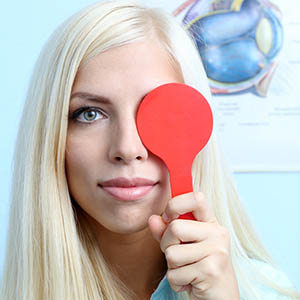Can adults benefit from vision therapy?
Do you feel like your work performance is impacted by constant headaches or eye strain?
Are you finding it difficult to meet deadlines?
What is vision therapy?
Vision therapy is a remarkably effective program that improves vision skills to achieve clearer and more comfortable vision.
Through a series of progressive therapeutic eye exercises, patients develop normal visual skills. Enhancement of the visual skills is achieved by improving the communication between your brain and your eyes.
Vision therapy can be best understood as gym for the brain!
Vision therapy is designed as an individual and personalized treatment program, often used in conjunction with other treatments such as eyeglasses or eye surgery. Vision therapy is performed under the supervision of an eye doctor and performed once per week in sessions lasting 30-45 minutes.
Home practice is given to reinforce exercises learned during in-office therapy sessions. Commitment to weekly sessions and therapy homework assignments are essential for optimal results.
Is vision therapy effective for adults?
YES. Vision therapy is often just as effective for adults as it is for children.
Adults can succeed with vision therapy as well as children, due to neuro-plasticity. Neuroplasticity enables your brain to remain dynamic and flexible throughout your life.
Additionally, adults are usually highly motivated to improve their visual skills— this gives them the energy to push through any difficult obstacles. Visual function training used in vision therapy can be compared to learning a trade or playing an instrument— the more you practice or train, the stronger and more skillful you will become.
Vision therapy can treat a variety of vision conditions:
- Eye strain
- Strabismus (eye turn)
- Amblyopia (lazy eye)
- Convergence insufficiency (eye teaming)
- Saccadic dysfunction (eye tracking)
- Traumatic brain injury (concussion)
How does a lazy eye affect vision?
Amblyopia, commonly known as a “lazy eye” is a neuro-developmental vision condition. Lazy eye develops when one eye is unable to achieve normal visual acuity, causing blurry vision in the affected eye, even with corrective eyewear. The condition also commonly presents with poor depth perception, and reading difficulties.
According to research, amblyopia affects up to 1 in 33 of the population— this means up to 10 million people in the USA may have a lazy eye!
What causes a lazy eye?
Lazy eye is diagnosed when the neural connections between the lazy eye and the brain have been affected. A healthy eye-brain connection can be compared to a multi-lane highway— the eye sends visual signals to the brain to be interpreted, and the brain sends signals back to the eye to enable clear vision.
However, in the case of amblyopia, the “highway” does not work as a multi-lane road due to a disconnect in the visual pathways. Therefore, the connection between the brain and the lazy eye may be similar to a one-lane street, or even a walking track.
Vision conditions that may cause lazy eye
- Refractive amblyopia is the most common form of amblyopia. It can be divided into two types:
- Isometropia is a significantly high, but equal optical prescription in both eyes.
- Anisometropia is a significant difference in eyeglass prescription (i.e. nearsightedness, farsightedness, astigmatism) between the two eyes.
- Constant strabismus is a constant noticeable turn of one eye in any direction. An inward turn of the eye (Esotropia) is the most common. Amblyopia resulting from strabismus can be easier to detect because the noticeable eye turn alerts to a vision problem.
- Ocular obstruction can result from any physical blockage of vision, such as a cataract, trauma, lid droop (ptosis), or blocked tear duct.
A lazy eye can develop as a result of the conditions listed above, however the true underlying cause of lazy eye is a reaction in the brain, called suppression.
Suppression occurs when the brain actively ignores all of the visual information coming from one eye to avoid blurry or double vision (diplopia). Suppression can cause serious consequences, and can lead to an eye turn, also known as strabismus.
Do I have a lazy eye?
It may be difficult to recognize a lazy eye because the condition usually develops in one eye, and may not present with a noticeable eye turn.
It is therefore important to schedule an eye exam if you notice any of the following signs and symptoms.
- Shutting one eye or squinting
- Rubbing eyes often
- Poor eye-hand coordination
- Accident prone
- Poor depth perception
- Difficulty with fine eye movements
- Reduced reading speed and comprehension
- Poor eye focusing skills
- Inability to follow an object with just the eyes
- A cross-eyed appearance
- Unusual eye movements such as flickering or blinking
Schedule an appointment with a vision therapy eye doctor to help improve your visual skills.
SEE RELATED: Vision Therapy for Adults: Success Stories
Is vision therapy effective in treating adults with lazy eye?
Yes! Vision therapy has been shown to greatly improve the visual skills of the lazy eye by re-training the visual system.
Recent studies have shown that the neural pathways of the brain can be enhanced at any age—this means that a lazy eye can actually be treated at any age, even into adulthood.
Vision therapy for adults can be very effective, but might take longer to achieve the optimum results. Of course, the earlier the condition is diagnosed the better the outcome usually is.
For many decades, it has been thought that amblyopia (lazy eye) can only be treated for children up to around ages seven to nine years— meaning that lazy eye treatment was usually not provided to children older than nine.
The NEI research was conducted at 49 eye centers across the U.S., including the Bascom Palmer Eye Institute, Mayo Clinic, The Emory Eye Center, The Ohio State University, Southern California College of Optometry, and the State University of New York, College of Optometry.
The study includes 507 children between the ages 7-17, and found that it is possible to improve eyesight even in children up to age 17.
Results showed:
- 53 percent of 7 to 12 year-olds had improved vision following treatment!
- 47 percent of 13 to 17 year old children also gained improved eyesight!
Through vision therapy, the two eyes will be trained to work together to achieve clear and comfortable binocular vision.
Some vision therapy programs to treat amblyopia may include:
- Accommodation (focusing)
- Fixation (visual gaze)
- Saccades (switching eye focus, “eye jumps”)
- Pursuits (eye tracking)
- Spatial skills (eye-hand coordination)
- Stereopsis (3-D vision)
Can adults have convergence insufficiency?
Yes. Convergence insufficiency (CI) is a highly treatable binocular vision condition that can affect adults.
Convergence insufficiency affects near vision and eye muscle coordination. Convergence of the eyes occurs when the two eyes need to focus on a close object, such as a book, computer, tablet, smartphone, etc. Convergence insufficiency means the eyes struggle to focus for near tasks, affecting work performance and attention to tasks.
What are the symptoms of CI?
There are many different symptoms that can develop as a result of CI— these are the most common:
- Eyestrain
- Headaches or muscle tension
- Blurred or double vision
- Difficulty reading and concentrating
- Uses finger or ruler when reading
- Avoidance of close work
- Poor hand-eye coordination
- Anxiety
- Motion sickness/dizziness
If you have CI, the following tasks may be challenging:
- Computer work
- Attention
- Reading
- Comprehension
- Writing
Untreated CI can lead to avoidance behaviors such as reading and close work, or the use of various strategies to combat symptoms, such as using a ruler or finger to keep one’s place while reading or taking frequent breaks.
Can CI cause visual suppression?
If untreated, convergence insufficiency can lead to more serious eye problems such as lazy eye (amblyopia) or even an eye turn (strabismus).
If the convergence problems are left untreated, suppression can result. Suppression of vision in one eye occurs when the brain actively shuts off one eye, causing loss of binocular (two-eyed) vision and depth perception.
In this case, some or all of the following symptoms may present:
- Trouble catching balls and other objects thrown through the air
- Avoidance of sports and games that require accurate depth perception
- Frequent mishaps due to misjudgment of physical distances:
- Trips and stumbles on uneven surfaces, stairs, and curbs
- Frequent spilling or knocking over of objects
- Bumping into doors, furniture and other stationary objects
- Sports accidents
- Avoidance of eye contact
- Poor posture while doing activities requiring near vision
- Frequent head tilt
- Problems with motion sickness and/or vertigo
Is vision therapy effective for treating adults with CI?
Yes! Vision therapy is the most effective treatment for CI.
Standard eyeglasses, contact lenses, medications, and surgery will not be effective in treating the condition.
Treatments for CI can be categorized as active or passive:
Active treatment: A multi-site randomized clinical trial funded by the National Eye Institute called the Convergence Insufficiency Treatment Trial showed that the best treatment for CI is supervised vision therapy in a clinical office with home reinforcement (15 minutes of prescribed vision exercises done in the home five days per week).
Passive treatment: Prismatic (prism) eyeglasses can be prescribed to decrease some of the symptoms.
-
- Although prism eyeglasses can relieve symptoms, they are not a “cure” and the patient typically remains dependent on the prism lenses.
- Adaptation problems can lead to the need for stronger prescriptions in the future.
In many cases, prisms are prescribed in combination with vision therapy. Vision therapy focuses on training the eyes to work together to improve 3-D vision, depth perception, and clear binocular vision.
Treatment exercises for CI may include:
- Eye tracking with pursuits and saccades
- Focusing for near and distance
- Depth perception practice
- Specialized equipment and tools such as prisms and lenses
- Training with computerized technology
The goal of vision therapy is to stimulate the communication between the brain and eyes, to enable clear and comfortable vision at all times.
Adults and eye turns (strabismus)
How does strabismus affect vision?
Strabismus occurs when the two eyes are unable to maintain proper alignment and focus together on an object— one eye looks directly at the object, while the other eye points in a different direction.
Strabismus is often referred to as, ‘crossed eyed’, ‘wall eyed’, an ‘eye turn’, or a ‘squint’.
The eye turn may be:
- Inward (esotropia, or ‘cross-eyed’)
- Outward (exotropia or ‘wall-eyed’)
- Upward (hypertropia)
- Downward (hypotropia)
The condition can be a constant or intermittent problem, and may consistently affect the same eye (unilateral) or affect a different eye each time (alternating).
Up to 5 percent of the population has some type of strabismus.
Strabismus does not go away on its own— but it is usually treatable.
What causes strabismus?
Strabismus that affects adults can develop in adults may be caused by:
- Severe farsightedness (hyperopia)
- Lazy eye (amblyopia)
- Significant difference of optical prescription between the two eyes
- An ocular muscle weakness (eye movement problems)
- Head trauma or stroke
- Brain tumors or other systemic health issues
What are the signs and symptoms of strabismus?
Strabismus may initially cause double vision that can be quite uncomfortable. To prevent double vision, the brain begins to actively ignore visual input from the affected eye, often resulting in amblyopia (lazy eye) or an eye turn, where the eyes are no longer aligned.
The most common sign of strabismus is noticeable misalignment of the eyes, where one eye is turned up, down, in, or out when compared to the other.
Other symptoms can include:
- Headaches
- Eye strain
- Double vision
- Reading difficulty or fatigue
Is vision therapy effective for treating adults with strabismus?
Yes! Vision therapy is highly effective for the treatment of strabismus.
A vision therapy program for strabismus will include improvement of:
- Eye alignment
- Eye teaming
- Eye focusing
- Eye movements
- Binocular vision
- Visual processing
Therapeutic lenses, prisms, and filters may be used as part of a vision therapy program. Vision therapy not only involves ocular muscle training, it also includes training and development of the eye-brain connections (neuroplasticity) required for clear and comfortable vision— resulting in a lasting cure.
Sometimes, a program of vision therapy may be recommended by your eye doctor after strabismus surgery in order to re-train the visual system.
It is important to treat strabismus as early as possible, as the eye turn may be a result of a serious health issue.
If you have an untreated vision problem you may be experiencing difficulty at home, at work, and even during sports activities. There is no need to continue suffering!
LEARN MORE: Guide to Vision Therapy for Adults
Schedule an eye exam and vision evaluation for a proper diagnosis, and to discuss if a vision therapy program is the appropriate treatment for you.









